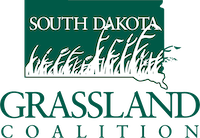By Garnet Perman
The cold snowy “spring” of 2018 will be remembered by many South Dakota cow calf producers as a night-mare calving season. Perhaps it’s time to think about calving later next year. Most proponents of later calving were influenced by Dr. Dick Diven, who published research in the early 1990’s advocating calving much later into the spring than the usual February-April window that most Northern Plains producers are accustomed. According to the Ranching for Profit website, Diven presented data showing that at 40ºN (the Kansas-Nebraska border) a cow in body condition score 6, calving in February, would take an average of 73 days to start cycling. Calving in June, an identical cow would start cycling in just 38 days. He showed that the closer calving is to the summer solstice, the shorter the postpartum interval becomes. He also showed that the further north you go, the more extreme the difference.
Pat Guptill, Quinn, SD made the switch to May and June calving over 10 years ago. Guptill follows Diven’s advice to match peak cow nutritional needs with peak grass performance. For their ranch, that means an early May calving date. “According to Diven, I’m two weeks early, but we have tame grass that peaks early in May.” Bill Slovek, Philip, SD, is still in the process. He used to start mid-February. Every year for the past several years he’s moved his calving dates by a week for everything but some breeding stock. Theoretically his calving start should be later than early April, but shorter gestational periods have made the switch slower. This year he’ll start breeding July 11, with plans to move calving back farther by at least a couple of weeks.
The benefits of later calving include: (1) Lower fuel consumption–Guptill ‘s records show he used 1600 gallons of diesel fuel to feed cows when he calved in March, and only 295 gallons calving in May. (2) Less hay fed means less hay put up, again increasing profitability. With later calving, cattle can be in a condition score 3 in March and end up being condition score 6 when they calve due to available forage instead of supple-mentation. (3) Cows in excellent body condition at calving breed back easier. (4) They don’t pull as many calves as they used to, and the calves generally tend to be healthier. Calves are born with a summer hair coat. The stress of cold, wet weather and muddy or snowy calving conditions is hard on their still developing immune system. (5) Decreased stress and labor for the human component. The day of this interview Guptills checked the herd in the morning and confidently spent the entire day at a track meet. Slovek noted that is a lot more fun to look for baby calves in green grass than searching snow banks. Also, the days are so much longer now that he can check before sunset and first thing in the morning and not bother checking at night, even with heifers.
A common concern regarding later calving is that summer heat may affect conception rates. Neither Guptill nor Slovek has found this something to be concerned about. Slovek is more concerned about enlarged udders from producing too much milk because of the fresh forage. “I may have to back off on milk,” he said.
Things to consider when planning later calving dates include possible changes in weaning dates and marketing. Slovek said, “The calves will be lighter, but not as much as you’d think, and they’ll be worth more per hundred.” He’s found that December weaning is easier on calves than October weaning. Guptill leaves them on the cow well into the winter.
Understand that peak forage varies by location and type of forage available. A general guideline for native pastures is observing when local wildlife such as deer or antelope give birth. Both men have found that later calving adds more than it takes from their operation. “I will go out of the cow business before I go back to March calving,” said Guptill.
